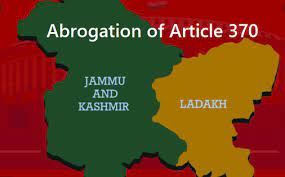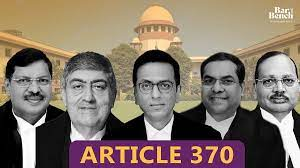Is Article 370 being equated to Basic Structure of Constitution, asks Supreme Court
"Indian Constitution is a live document, it is not static" - the Constitution Bench
“How can you say that the Parliament could not have exercised its preliminary amending powers to abrogate Article 370,” Chief Justice D Y Chandrachud during hearing on Thursday (second day in the highly sensitive case) grilled counsel Kapil Sibal.
“Will that not amount to equating Article 370 with the principle of Basic Structure of the Constitution when you say the abrogation of Article 370 can never be done?” Justice S.K. Kaul asked.
There was nothing within the constitutional structure which empowered the President or Parliament to abrogate Article 370, argues petitioners’ counsel Kapil Sibal.
“The abrogation of Article 370 was a purely political act. There was nothing within the constitutional structure which empowered the President or the Parliament to abrogate Article 370,” Sibal remarked.
On the first day of hearing on Aug 2, Justice B.R. Gavai asked Mr. Sibal why Article 370 was mentioned in the Constitution only as a “temporary” provision.
“So, you are saying that though Article 370 was created as a temporary provision, it became permanently engrafted into the Constitution after 1957 with the dissolution of the Constituent Assembly,” Justice S.K. Kaul asked Sibal. The court room drama was punctuated with observations made in lighter vein.
“On the lighter side, Mr. Sibal, are you saying you would have done it differently,” Justice Kaul asked.
The senior lawyer responded that Article 370 was not the Basic Structure, but a “compact” entered into between two sovereigns [the princely State of Jammu and Kashmir and the Government of India] and engrafted in the Indian Constitution.
“Unlike the case in some other princely States, the Indian government did not take over Jammu and Kashmir… You [government] want to take over J&K, you could have done it as a political act, but how do you do it from within a constitutional structure?” Sibal argued.
But the Chief Justice said Mr Sibal was treading on thin ice there. “But is it not possible that such a compact could be overridden by the sovereign of the succeeding State [Government of India],” the Chief Justice asked.
Governor and Union Government acted in Tandem to Abrogate Article 370: Kapil Sibal
Sibal shed light on the sequence of events leading to the abrogation emphasising that on June 19, 2018, the BJP withdrew its support to the Coalition Government of Jammu and Kashmir.
Within a day of this, on June 20 2018, the Governor exercised the power conferred to him under Section 92 of the Constitution of Jammu and Kashmir and declared the 'Governor's Rule' in the State and assumed the functions of the Government and Legislature of the State.
Some highlights:
Sibal: "This is a pure political act. The governor and government were acting in tandem. They wanted to get rid of 370. Why would the governor on June 20, after withdrawal of support on June 19, suspend the assembly? Not allow any political affiliation, so a new government could be formed.
--- There is no council of ministers, no government in place. But he sends a report that government of the state cannot be carried out. There are no negotiations, no communication."
CJI Chandrachud:
Of course, this has the optics of the way it was done.
But there was no challenge to anything that was done. What exactly was the frame of the challenge?
Sibal: The question is what is the power under 356. The quintessential object of 356 is to restore democracy. You take over because a government cannot run for a temporary period, for the restoration of democracy. You don't use 356 for its decimation
CJI: But can a ratification be done under 356? In relation to that particular state legislature?
Sibal: Ratification is of the state, so there are two authorities - one parliament passing the law and then the state authority ratifying it. You can't take over both. It's like clapping with one hand. You can't introduce a bill.
Justice Surya Kant: What was the procedure followed in passing the Constitution orders?
Sibal: It was through a presidential notification- after taking the consent- concurrence or consultation. That's how it's made applicable. And the views of the people were to be taken
--When all states were integrated into the Union, they didn't need consent. So you lose the link between the centre and the state altogether. You absorb the powers of the state with yourself as the executive, as well as the parliament and the legislature. And you decide without reference to any other institution.
Sibal further added: "The people who gave themselves this constitution are left out of the process. This is essentially a break down of the constitutional structure."
Constitution is a live document, it is not static: Supreme Court
Justice Kaul: Constitution is also a live document. It's not static. Can you say that there is no mechanism to change it even when everyone wants to change it?
CJI: Can parliament not have amended the constitution exercising the 368 power to abrogate 370?
Justice Gavai: Suppose the parliament decides to make the entire provisions applicable to J&K, they can under clause (d)?
Sibal: Yes, the residuary power remains with the state. They can do it.
Justice Gavai: Your argument is that unless the views of the entire population of the state of J&K is taken into consideration, the abrogation can't be done?
Sibal: I understand that at some stage or another, this had to be done. But then it must follow the constitutional way to be doing it.....This was a political process, carried through constitutional means.
Justice Kaul: Everything is a political process Mr Sibal, the question is if it fits in the constitution.
Sibal: The council of ministers was suspended. The governor didn't even wait for a day.
Justice Kaul: That's also a part of the political process.
Sibal: Why would governor do that? Because they wanted to get rid of 370. Section 53 gives the governor power to do this.
More highlights:
Sibal: The constituent assembly in making the constitution has no partisan intent. As a legislature, your intent may be partisan, but as a constituent assembly, it can't be partisan.
Justice Khanna: At the time when the constitution was adopted, there was no constitution of J&K and no constituent assembly but they were aware that constituent assembly will be made. So why can't we interpret the Constitution?
Justice Khanna: If the objective was not to put Article 370 in a straightjacket, which is obviously clear, it's a flexible article.
Sibal: That has nothing to do with 370(3). There's no flexibility there.
Justice Khanna: When they made it, there was no legislative assembly. That's a fact. So, when we interpret the term here can we interpret it to include legislative assembly?
Sibal: How can you interpret a term in the constitution which says constituent assembly as a legislative assembly.
CJI: Your argument is that what is to be done by constituent assembly cannot be done by legislative assembly. What happens when there's no constituent assembly? Do you create a fresh one?
Sibal: When the constitution was framed, there was a dialogue between the Maharaja and constitution makers. Both decided to put it in. You must understand the historic context. It didn't happen in isolation.












No comments:
Post a Comment